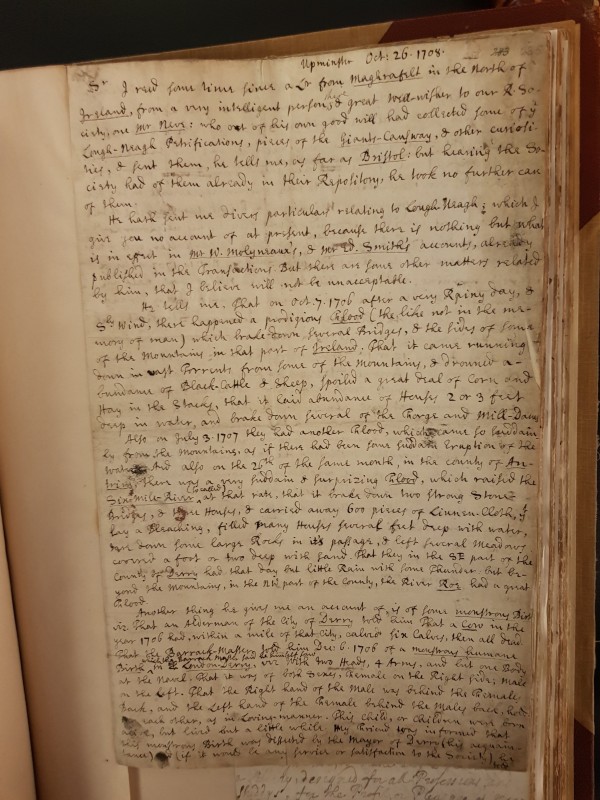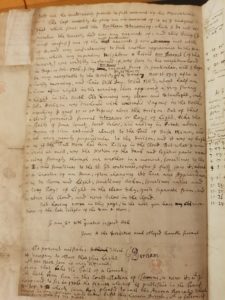William Derham to Hans Sloane – October 26, 1708
Item info
Date: October 26, 1708 Author: William Derham Recipient: Hans SloaneLibrary: British Library, London Manuscript: Sloane MS 4041 Folio: ff. 235-236
-
Language
English
-
Library
British Library, London
-
Categories
Astronomy, Curiosity Reports, Medical Reports, Royal Society, Scientific
-
Subjects
Conjoined Twins, Eclipses, Flood, Hermaphroditism, Ireland, Monstrous Births, Natural Disasters, Weather
-
Date (as written)
October 26, 1708
-
Standardised date
October 26, 1708
-
Origin (as written)
Upminster
-
Others mentioned
Mr Ed. Smith Mr Neve Mr Barret William Molyneux
-
Patients mentioned
Original Page

Transcription
[fol. 235r]
Upminster Oct: 26. 1708.
Sr
I recd some time since a Letter from Maghrafelt in the North of
Ireland, from a very intelligent person ^there^, & great well-wisher to our R. So-
ciety, one Mr Neve: who out of his own good will had collected some of ye
Lough-Neagh Petrifications, pieces of the Giants-Causeway, & other curiosi-
ties, & sent them, he tells me, as far as Bristol: but hearing the So-
ciety had of them already in their Repository, he took no further care of them.
He hath sent me divers particulars relating to Lough-Neagh; which I
give you no account of at present, because there is nothing but what
is in effect in Mr W. Molyneaux’s, & Mr Ed. Smiths accounts, already
published in the Transactions. But there are some other matters related
by him, that I believe will not be unacceptable.
He tells me, that on Oct. 7. 1706 after a very Rainy day, &
Southerly Wind, there happened a prodigious Flood (the like not in the me-
mory of man) which broke down several Bridges, & the sides of some
of the Mountains in that part of Ireland. That it came running
down in vast Torrents from some of the Mountains, & drowned a-
bundance of Black-Cattle & Sheep, spoiled a great deal of Corn and
Hay in the Stacks, that it laid abundance of Houses 2 or 3 feet
deep in water, and broke down several of the Forge and Mill-Dams.
Also on July 3. 1707 they had another Flood, which came so suddain-
ly from the Mountains, as if there had been some suddain Eruption of the
water. And also on the 26th of the same month, in the county of An-
trim, there was a very suddain & surprizing Flood, which raised the
Six-Mile-River ^(so called)^ at that rate, that it broke down two strong Stone
Bridges, & three Houses, & carried away 600 pieces of Linnen-Cloth, that
lay a Bleaching, filled many Houses several feet deep with water
tore down some large Rocks in it’s passage, & left several Meadows
covered a foot or two deep with sand. That they in the South East part of the
County of Derry had that day but little Rain with some Thunder: but be-
yond the Mountains, in the North West part of the County, he River Roe had a great
Flood.
Another thing he gives me an account of, is of some monstrous Birth
viz. That an Alderman of the City of Derry told him That a Cow in the
year 1706 had, within a mile of that City, calved six Calves, then all dead.
That the Barrack-Master told him Dec. 6. 1706 of a Monstrous humane
Birth ^which the Barrack Master saith he himself saw^ in London-Derry, viz With two Heads, 4 arms, and but one Body
at the Navel. That it was of both Sexes, Female on the Right side; Male
on the left. That the Right hand of the Male was behind the Females
Back, and the Left hand of the Female behind the Males back, hold-
ing each other, as in Loving-manner. This Child, or Children were born
alive, but lived but a little while. My Friend was informed that
this monstrous Birth was dissected by the Mayor of Derry (his acquain-
tance) and (if it would be any service or satisfaction to the Society) he

Sloane MS 4041, f. 235v
[fol. 235v]
told me he could easily procure a full account of his Observations.
The last curiosity he gives me an account of is as I imagine
that which some call the Northern Streaming, which I do not re-
member the Society had ever any accounts of; and this being (I
must confess) one of the
of it, and very consentaneous to such another appearance in the Hea-
vens, which my ingenious Neighbour & Friend Mr Barret (of the
Society) was credibly informed of, was seen in his neighbourhood
in Sep: or Oct: 1706, I say
be very acceptable to the Society. ^It is thus^ “On Sunday Nov: 16 1707 after a
“Frosty morning, and Fair still Day, Wind NorthWesterly, about half an
“hour after eight in the evening, there appeared a very strang
“Light in the North. The Evening was clear and Starlight, only
“the Horizon was darkened with condensed Vapours in the North,
“reaching I guess 10 or 15 degrees above the Horizon. Out of this
“Cloud proceeded several Streams or Rays of Light, like the
“Tails of some Comets, broad below, and ending in Points above.
“Some of them extended almost to the Tail of Ursa Minor, and
“all were nearly perpendicular to the Horizon, and it was as bright
“as if the Full Moon had been Rising in the Cloud. But what I won-
“dered at most, was the Motion of the dark and lighter parts run-
“ning strangly through one another in a moment; sometimes to the
“East, and sometimes to the West. It continued, after I first saw it, about
“a Quarter of an Hour, often changing it’s Face and Appearance,
“as to Form and Light; sometimes broken, sometimes entire and
“long Rays of Light in the clear Sky, quite separate from, and
“above the Cloud, and none below in the Cloud.
Not having room in this page in the next you have my observa-
tions of the late Eclipses of the Sun & Moon.
I am Sir with greatest respect both
Yours & the Societies much obliged humble servant
Wm Derham
To prevent mistakes
it necessary to observe that this Light
which Mr Neve saw is very different
from that like the Tail of a Comet,
which hath been seen in the Constellation of Taurus, or near it; which I
happened to see in 1706. the Figure whereof is published in the Trans:
Number 305 &
name in my opinion would better befit this Lumen Boreali, which is seldom, if
ever seen out of the North.

Sl MS 4041, f. 236r
[Fol. 236r]
The Eclipse of the Sun on Sept: 3 in the morning at Upminster
The beginning of the Eclipse we could not see for Clouds
6h.44.15 The Sun peeped out of the Clouds, & I judged by my Eye that about
one Tenth of a Digit was Eclipsed
Then Clouds nearly all the time of the Eclipse. But at
8.31.15 A little obscuration appeared through the Telescope.
8.32.45 A very little obscuration, through the Telescope.
Then Clouds and at
8.35.45 We could discern no remains of the Eclipse through the Telescope.
From these Observations I imagine the End of this Solar Eclipse,
Was much about 8h 33l in the morning.
The Eclipse of the Moon Sep: 18 in the Evening at Upminster
As I was that evening coming from London, I observed for half an
hour, or more, a thin shade to possess that part of the Disk where the E-
clipse began, which remained a good while after the Eclipse was over.
After I got home, I made a shift to mount Telescopes, & get all things
in readiness before the Eclipse began. And the principal Observations I made
thereof were these following.
7h 56 30 A thin Penumbra.
7 57 40 A darker penumbra.
7 59 00 Yet darker, which may pass for the Beginning of the Eclipse.
8 00 00 The Eclipse no doubt begun.
9 1 00 The Lucid parts of the Moon, not long before the Middle of the E-
clipse, were 925 parts of my Micrometer.
9 16 40 Diameter of the Moon 1634 parts of the Micrometer.
10 23 11 The End of the Eclipse draws nigh.
10 25 0 A little obscuration.
10 26 0 Less.
10 28 15 A very little, excepting the Duskishness befor mentioned.
Derham was a Church of England clergyman and a natural philosopher, interested in nature, mathematics, and philosophy. He frequently requested medical advice from Sloane, and likely served as a physician to his family and parishioners (Marja Smolenaars, “Derham, William (1657-1735)”, Oxford Dictionary of National Biography, Oxford University Press, 2004 [http://www.oxforddnb.com/view/article/7528, accessed 7 June 2011]).
There is the remnant of a red seal on the external part of the letter (fol. 236v].

Sloane MS 4041, f. 236 v
Patient Details
-
Patient info
Name: N/A
Gender:
Age: -
Description
-
Diagnosis
-
Treatment
Previous Treatment:
Ongoing Treatment:
Response: -
More information
-
Medical problem reference